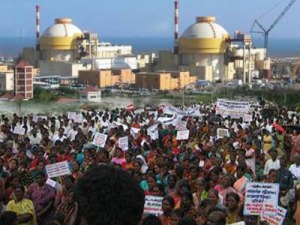Kudankulam Reactor: Criticality Now And Safety Six Months Later
By VT Padmanabhan, R Ramesh & V Pugazhendi
27 August, 2012
Countercurrents.org
 How fast can you dig a swimming pool, 100x20x4 meters? If we ask this question to an average Indian, (s)he will say “not in this life”. What about the Nuclear Power Corporation of India Ltd (NPCIL) which has got tons of public money and thousands of scientists and engineers on its payroll and claims a reactor complex can be constructed in six years? If one goes by a counter affidavit submitted in the Madras High Court by Dr Soumen Sinha, senior scientific officer at the Atomic Energy Regulatory Board, NPCIL would need a minimum of 20 months to construct a water tank with a capacity of storing 8,000 cubic meters of water.
How fast can you dig a swimming pool, 100x20x4 meters? If we ask this question to an average Indian, (s)he will say “not in this life”. What about the Nuclear Power Corporation of India Ltd (NPCIL) which has got tons of public money and thousands of scientists and engineers on its payroll and claims a reactor complex can be constructed in six years? If one goes by a counter affidavit submitted in the Madras High Court by Dr Soumen Sinha, senior scientific officer at the Atomic Energy Regulatory Board, NPCIL would need a minimum of 20 months to construct a water tank with a capacity of storing 8,000 cubic meters of water.
AERB had given clearance for the Kudankulam Nuclear Power Plant (KKNPP) on condition that there should be a reserve of 60,000 cubic meters of water on the campus. Today they have a reserve of little over 10,000 cubic meters, sufficient to run two reactors for one and a half days or cool the reactor cores (on a shut down mode) for about ten days. This reserve is grossly insufficient, if we compare the situation in other nuclear plants in India and abroad. Seeing this dangerous situation, the post-Fukushima Task Force appointed by NPCIL had recommended constructing an 8,000 cubic meter tank in May 2011(1). This recommendation was made by an in-house committee headed by an official from the Madras Atomic Power Station (MAPS).
We do not blame NPCIL for forgetting the Task Force Recommendation on water. In fact, they have been repeatedly reminding us about this. For instance in Nov, 2011, Kasinath Balaji, the then site director of KKNPP had told the media that he was “setting up a tank of 8,000 cubic meter capacity as an additional source of water.” (2) Two months later, an Expert Committee headed by Dr AE Muthunayagam had said that “there is a provision to augment this (the existing) capacity by adding an 8,000 CuM capacity storage tank”.
NPCIL which repeatedly projects its high level of safety culture had the temerity to apply for final clearance for commissioning the reactor without implementing this major recommendation related to safety. Construction of a water tank does not involve any complex technology, import or expertise. And AERB, the regulator par excellence has the courage to give the final clearance for commissioning the reactor and to inform the High Court that the tank will be constructed in another six months. (4) Did the regulator ask the reasons for non-implementation of this simple safety related step during the past 14 months?
We started this note with the mention of a swimming pool. This tank we are talking about has nothing to do with sports or recreation. Water is the only remedy a nuclear reactor and its spent fuel pool will take when they report sick. And if sufficient amount of water is not provided, they will behave like a million drunken men or even much worse than that. Water was central to all major nuclear disasters the world has experienced at Three Mile Island, Chernobyl and Fukushima.
The first reactor at KKNPP will attain its first criticality any time from now. All accidents, including nuclear accidents, do not visit after getting prior appointments. What if such an accident occurs during the six months grace period given for digging the pool?
Notes
1. S. Krishnamurthy, 2011, A5 INTERIM REPORT OF TASK FORCE ON SAFETY EVALUATION OF THE SYSTEMS OF KKNPP POST FUKUSHIMA EVENT
2. More safety features at KNPP soon New Delhi. Deccan Herald, Nov 11, 3011, DHNS
3. AE Muthunayagam, et al, 2011, SAFETY OF KUDANKULAM NUCLEAR POWER PLANT AND IMPACT OF ITS OPERATION ON THE SURROUNDINGS REPORT BY EXPERT GROUP CONSTITUTED BY GOVT. OF INDIA, page 18
www.barc.ernet.in/egreport.pdf
3. Soumen Sinha, 2012, Counter affidavit dt 22 Aug 2012 in writ petition No No 22353/2012 – Sundararajan vs Union of India, Department of Atomic Energy (DAE) and others
Dr. V. Pugazhendi is acclaimed for his rigorous and credible studies on health impact of radiation around Kalpakkam nuclear site. He is an activist belonging to the Doctors for Safer Environment
>>>>>>>>>>>
Dr. R. Ramesh a medical practitioner, who has written books on the geology of Kudankulam
>>>>>>>>
VT Padmanabhan is a researcher in health effects of radiation. He has led epidemiological investigations among people exposed to high radiation in Kerala. He has also studied the occupational radiation hazards among workers of Indian Rare Earths, genetic effects of children exposed to MIC gases in Bhopal, health hazards to workers in a viscose rayon unit in Madhyapradesh and reduction of birth weight of babies near a beverage bottling plant in Kerala. He has visited several contaminated sites in Belarus and Japan and had extensive interactions with the survivors.His papers have been published in International Journal of Health Services, Journal of American Medical Association, International Perspectives in Public Health, the Lancet and Economic and Political Weekly. He is a member of the European Commission on Radiation Risk, an independent body of experts appointed by the Green MEPs in Europe. He can be reached at [email protected]
Comments are moderated


